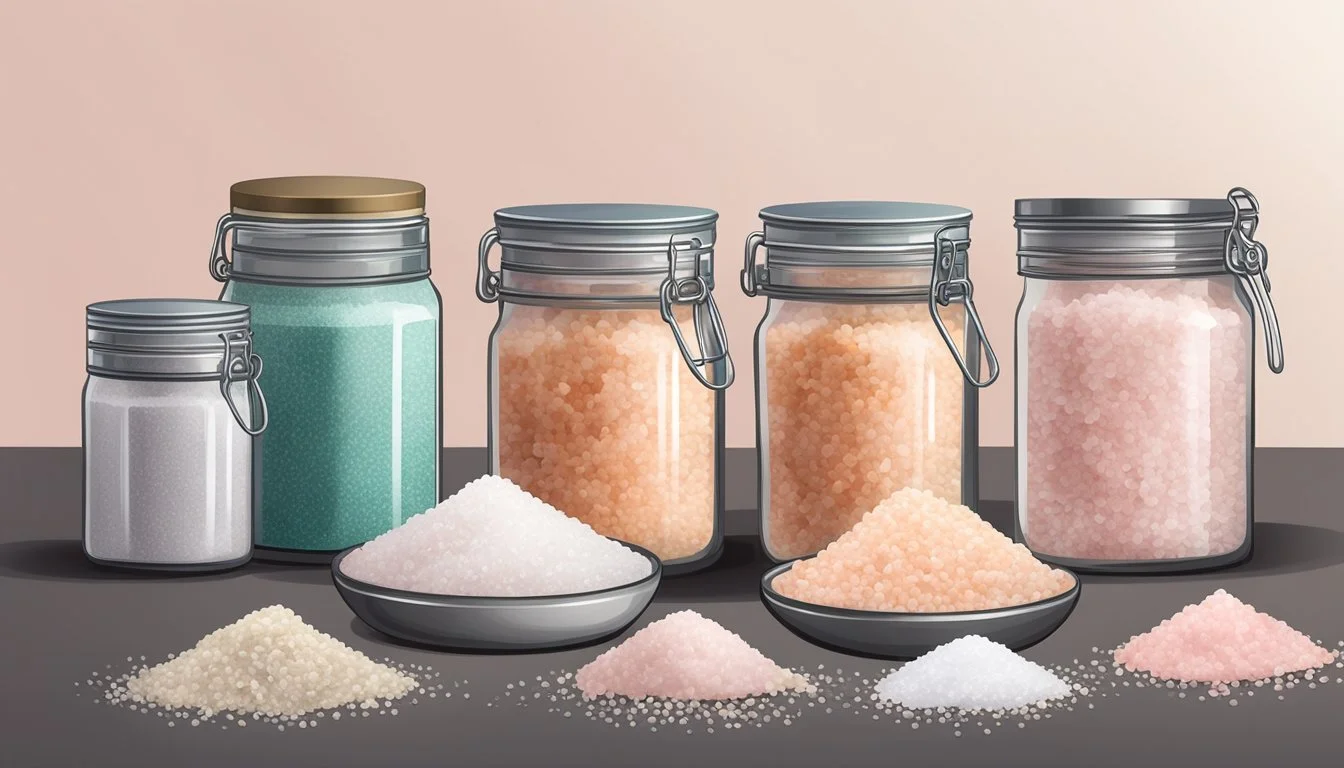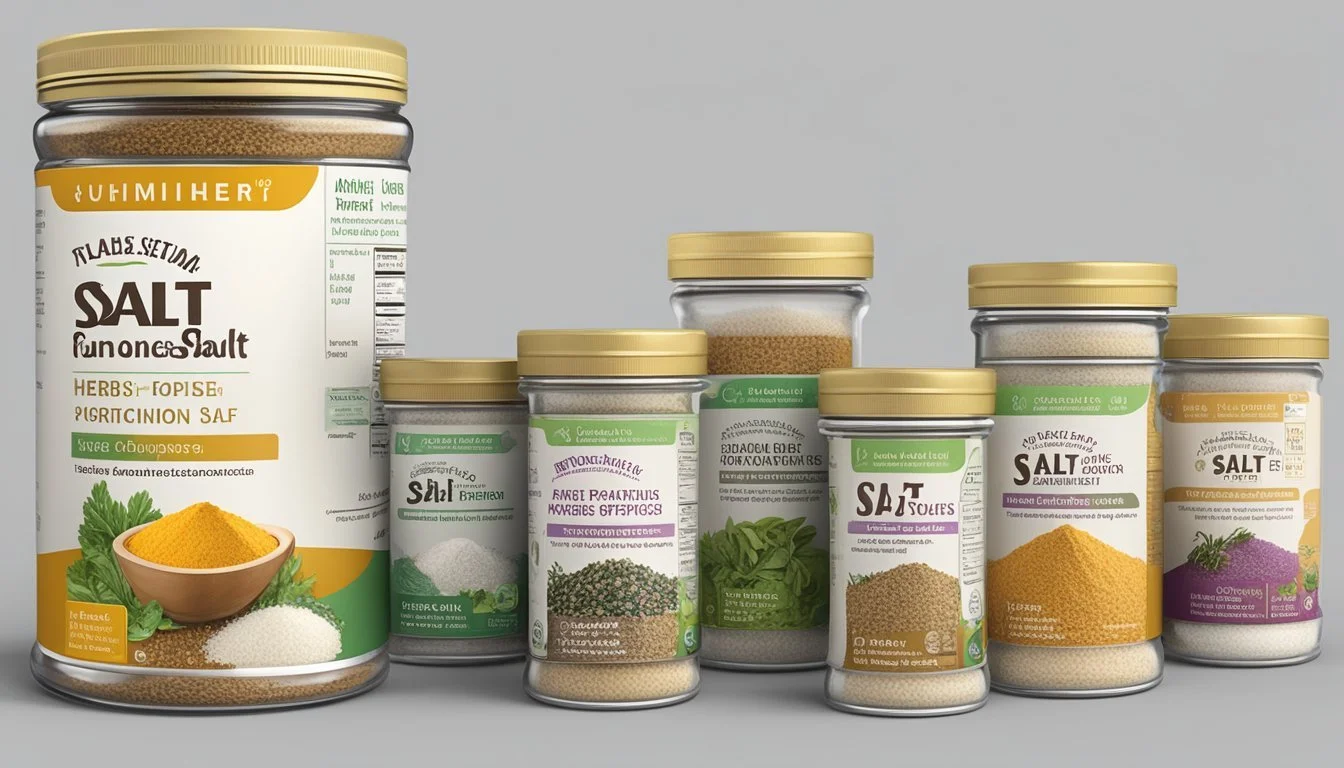Kosher Salt Substitutes
Best Alternatives for Cooking
When cooking, finding a substitute for kosher salt can be essential, especially when it's a key ingredient that brings out the flavor in various recipes. Flaky sea salt, such as Maldon sea salt, is one of the best substitutes due to its similar texture and ability to enhance the taste of dishes without being overly salty. Another great option is Himalayan pink salt, which can be used as a 1:1 replacement for kosher salt and is known for its rich mineral content.
Other useful substitutes include pickling salt and table salt. Pickling salt dissolves quickly, making it an excellent choice for brining or fermenting, while table salt can be used at a slightly adjusted ratio to match the flavor of kosher salt. Each of these alternatives provides unique benefits and can be seamlessly integrated into your cooking routine to ensure delicious results.
Understanding Kosher Salt
Kosher salt is a popular choice in kitchens for its texture, structure, and versatility. It is particularly valued for seasoning, curing meats, and brining.
Characteristics of Kosher Salt
Kosher salt is characterized by its coarse grains and lack of additives. This coarse structure allows for even distribution when sprinkled on food, enhancing flavor without overwhelming the dish. The larger grain size makes it easier to handle and measure, particularly for recipes that require manual seasoning. Unlike table salt, kosher salt typically doesn't contain iodine or anti-caking agents, which can affect taste and purity.
Culinary Uses of Kosher Salt
Kosher salt is frequently used in various culinary applications due to its distinct texture and structure. It’s ideal for seasoning meat, vegetables, and other dishes, providing an even coat without dissolving too quickly. For curing meats, kosher salt penetrates slowly, ensuring a balanced and uniform cure. It is also a fundamental component in brining solutions, helping to retain moisture and flavor in meats.
Benefits of Using Kosher Salt in Cooking
Using kosher salt in cooking offers several advantages. The coarse grains allow chefs to control the amount of salt added more easily compared to finer salts. Its pure, clean taste doesn't impart any unwanted flavors, making it versatile for both savory and sweet dishes. Additionally, even seasoning and enhanced texture achieved with kosher salt can elevate the quality of culinary creations, from steaks to pastries.
Health Considerations of Salt
The health implications of salt consumption primarily concern iodine content and sodium intake. Understanding these aspects can help make informed decisions for better health.
Iodine Content in Salt
Iodine is an essential mineral that supports thyroid function. Many salts, including table salt, are iodized to prevent iodine deficiency.
Iodized salt helps prevent conditions like goiter and hypothyroidism. The recommended daily intake of iodine is around 150 micrograms for adults.
Kosher salt and some sea salts are not iodized. This means they may not contribute to iodine intake unless the diet includes other iodine-rich foods like dairy or seafood. Non-iodized salts can be a concern in areas where iodine deficiency is prevalent.
For those relying heavily on non-iodized salts, incorporating iodine-rich foods or supplements might be necessary.
Salt and Sodium Intake
Sodium intake is directly linked to blood pressure. High sodium levels can lead to hypertension, increasing the risk of heart disease and stroke.
According to health guidelines, adults should consume less than 2300 milligrams of sodium per day. Reducing salt intake is a common recommendation for those with high blood pressure.
Different salts have varying sodium content. While table salt and kosher salt are nearly 100% sodium chloride, sea salt can have slightly lower sodium due to mineral impurities.
Choosing salt substitutes like potassium chloride-based products can help reduce sodium intake. Reading labels and being mindful of processed foods can assist in managing sodium consumption.
The Role of Salts in Cooking
Salt plays a multifaceted role in cooking, influencing flavor, preservation, and the effectiveness of marinades and spice rubs. Understanding these roles can enhance culinary skills and improve dish outcomes.
The Impact of Salt on Flavor
Salt is a fundamental flavor enhancer. It can heighten the natural flavors of ingredients, making them more vibrant and palatable. When used correctly, it balances sweetness and reduces bitterness.
For example, adding a pinch of salt to sweet dishes can make the sweetness stand out more. Conversely, it can make bitter vegetables like kale more enjoyable. Different salts, such as kosher, sea, and Himalayan pink salt, offer varying textures and subtleties in flavor.
Salt as a Preservative
Salt has been used as a preservative for centuries. Its ability to draw moisture out of food helps inhibit the growth of bacteria, making it essential for processes like pickling and canning.
In pickling, salt helps create an environment where only beneficial bacteria can thrive, thus preserving the food. In canning, salt enhances the process by ensuring long-lasting preservation of vegetables and fruits.
Salts Used in Marinades and Spice Rubs
Marinades and spice rubs benefit significantly from the inclusion of salt. Salt helps to tenderize meat by breaking down proteins, making it more receptive to the flavors of the marinade.
Different types of salt—such as kosher or sea salt—can be used based on the specific texture and level of saltiness desired. Spice rubs often combine salt with various herbs and spices to create a flavorful crust on meats, enhancing both taste and texture.
Types of Salts and Their Properties
There are various types of salts, each offering unique properties and uses in cooking. This section explains the key differences between common salts like table salt and kosher salt, various sea salts, and more exotic varieties.
Comparing Table Salt and Kosher Salt
Table Salt is the most common type of salt found in households. It is typically iodized and has a fine grain, which makes it perfect for baking and precise seasoning. Table salt often includes anti-caking agents to prevent clumping.
Kosher Salt has larger, coarser grains and is favored for its pureness and ability to draw moisture out of meats, making it popular in the koshering process. It generally doesn't contain additives like iodine, and its texture makes it ideal for sprinkling on food before cooking.
Sea Salt Varieties
Fine Sea Salt is closely similar to table salt but has a more delicate flavor. It dissolves quickly, making it ideal for soups, sauces, and baked goods.
Coarse Sea Salt has larger grains, similar to kosher salt. It adds a crunchy texture when used as a finishing salt and works well for seasoning meat and vegetables.
Flaky Sea Salt like Maldon sea salt, has a unique flaky texture. It provides a crunchy, burst of saltiness and is best used as a finishing salt for dishes like salads, grilled meats, and desserts.
Exotic Salts and Their Unique Features
Himalayan Pink Salt comes from mines in the Punjab region of Pakistan. It contains trace minerals like magnesium and potassium, giving it a distinctive pink color. It can be used both in cooking and as a finishing salt.
Fleur de Sel is a delicate, hand-harvested sea salt from the coastal regions of France. It has a high moisture content and a beautiful, crunchy texture, making it ideal for finishing dishes.
Hawaiian Red Salt, also known as Alaea salt, is enriched with volcanic clay, giving it a unique red color and earthy flavor. It is used in traditional Hawaiian dishes and for roasting meats.
Pickling Salt is free of additives and anti-caking agents, making it perfect for brines and pickling. Its fine, pure crystals dissolve easily and don’t cloud the brine.
Common Substitutes for Kosher Salt
When replacing kosher salt, knowing the key properties of your substitutes ensures proper seasoning and texture. Here, we explore three popular alternatives: sea salt, Himalayan pink salt, and table salt.
When to Use Sea Salt as a Substitute
Coarse sea salt shares many qualities with kosher salt, making it a preferred substitute. The large granules of both salts allow for even distribution and a similar crunch in recipes.
Sea salt contains natural minerals, which can add a nuanced flavor profile to dishes. It is available in both coarse and fine varieties, but coarse sea salt is best for replicating the texture of kosher salt.
Use a 1:1 ratio when substituting to maintain the desired saltiness without adjusting other ingredients. Because of its origins, fine sea salt can be used in baking due to its quick dissolution and uniform taste.
Opting for Himalayan Pink Salt
Himalayan pink salt is another excellent replacement for kosher salt. This salt, known for its distinctive pink hue, offers a comparable size in granules and contains various trace minerals that can enhance flavor.
Pink Himalayan salt is beneficial in koshering meat due to its coarse texture. It can also be used in finishing dishes, where the visual appeal of the crystals adds to the presentation.
Substitute at a 1:1 ratio for coarse kosher salt in cooking, ensuring a consistent saltiness and texture. Additionally, because it doesn’t dissolve as quickly as finer salts, it works well in slow-cooked recipes.
Using Table Salt in Place of Kosher Salt
Table salt, with its fine crystals, is a more concentrated form of salt, so adjustments are necessary when using it as a substitute. Typically, for every teaspoon of kosher salt, use about ½ to ¾ teaspoon of table salt.
This adjustment is crucial to prevent over-salting due to the fine texture and higher density of table salt. While it dissolves quickly, which can be advantageous in sauces or soups, the smaller granules will not provide the same texture as kosher salt.
Despite this difference, it remains a convenient and accessible option for most home cooks, ensuring seasoning is still achievable without specialized salts.
Specialty Salt Substitutes
Specialty salt substitutes offer unique flavor profiles and culinary benefits. These options can provide both traditional and creative twists in various dishes.
Flavorful Alternatives like Celery Salt and Flavored Sea Salts
Celery salt is a distinctive substitute with a refreshing, vegetal taste. Made from ground celery seeds and salt, it works well in salads, soups, and dressings. Celery salt complements tomato-based dishes and is a key ingredient in Bloody Mary cocktails.
Maldon sea salt and fleur de sel are high-quality sea salts known for their delicate flavors and flaky textures. Maldon salt dissolves easily, making it ideal for finishing dishes. Fleur de sel, harvested in France, adds a subtle briny taste and crunch to recipes.
Flavored sea salts, such as smoked, garlic, or herb-infused varieties, can elevate the taste of roasted vegetables, meats, and seafood. These flavorful alternatives bring an additional layer of complexity to a wide range of cuisines.
Utilizing Liquid Salts and Sauces
Liquid salts and sauces provide a unique way to incorporate salty flavors into dishes. Soy sauce is a versatile condiment that infuses a rich umami taste into stir-fries, marinades, and sauces. Its depth of flavor can replace kosher salt, especially in Asian cuisine.
Fish sauce, though potent, adds an intense savory note that can enhance soups, stews, and dressings. A few drops of fish sauce can replace salt while adding complexity to Thai and Vietnamese dishes.
Liquid forms like these not only introduce saltiness but also impart unique flavors, making them excellent substitutes in various recipes.
Using Salt Substitutes in Recipes
Incorporating kosher salt substitutes into recipes requires understanding their unique properties. Specific adjustments in both measurement and application ensure the best possible flavor and texture in dishes.
Adjustments for Salt in Dry and Wet Cooking Methods
When using salt substitutes in dry cooking methods such as grilling or roasting, the choice of substitute impacts the final texture. Flaky sea salt or coarse sea salt can mimic kosher salt, providing a cleaner flavor and similar crunch. For wet cooking methods like soups or sauces, finer substitutes like table salt or pickling salt dissolve quickly and distribute evenly, ensuring balanced seasoning.
Measuring Salt Substitutes Correctly
Proper measurement is essential when substituting salts to maintain the intended flavor. For every teaspoon of kosher salt, you can often substitute with 1 teaspoon of flaky sea salt or ¾ teaspoon of table salt. More delicate substitutes require precise measuring to prevent overly salty dishes, requiring adjustments based on their granule size and saltiness.
Tips for Salting While Cooking
Salting during cooking involves more than simply seasoning at the end. Integrating salt at different stages enhances flavors and textures. For instance, adding salt early in the cooking process for stews allows it to penetrate ingredients deeply. For salads, sprinkling fine salt right before serving helps maintain a fresh taste. Each salt substitute should be carefully considered based on its properties to achieve the desired culinary outcome.
Finding the Right Balance with Salt Substitutes
Balancing flavor with salt substitutes involves understanding their unique characteristics. Soy sauce, while providing a rich umami flavor, can also add liquid to the dish and needs to be used at the right stage. Himalayan pink salt, with its mineral content, offers a distinct taste that might require trial and error to perfect. Always taste and adjust gradually to avoid overpowering the dish.
Additional Considerations for Professional Chefs
Professional chefs often face unique concerns when substituting kosher salt in their recipes. Consistency is key in professional kitchens, and different salts can affect the outcome of a dish. Sea salt and Himalayan pink salt are popular alternatives, but chefs need to adjust the quantities due to differences in flakiness and coarse texture.
When using sea salt, chefs must consider its density; typically, less sea salt is required compared to kosher salt. Pickling salt dissolves more quickly and can be a valuable substitute for applications where fast dissolution is needed. This feature makes it suitable for brining and koshering meat.
A good substitute for kosher salt must also enhance the flavor profile. Soy sauce, miso, or fish sauce can introduce new dimensions to a dish, providing both saltiness and savory notes. These ingredients should be used judiciously to maintain the balance of flavors.
Some chefs use kosher salt for rinsing cocktails and sprinkling over dishes for texture. Coarse sea salt or Himalayan pink salt can replicate the crunch, but chefs should adjust the amounts to reflect different crystal sizes.
Substitute Use Case Adjustment Sea Salt General cooking, rinsing cocktails Use less than kosher salt Pickling Salt Brining, quick dissolving needs Approx. 1.25 tsp for 1 tsp kosher salt Himalayan Pink Salt Sprinkling, finishing dishes Similar to kosher salt Soy Sauce Adding savory flavor Use to taste
Adjusting salt amounts and considering each salt's properties ensures chefs achieve the desired results in their culinary creations.







